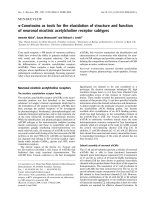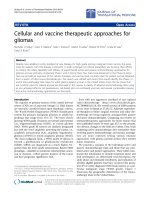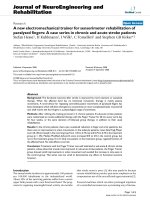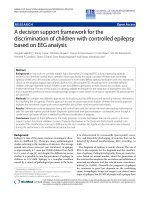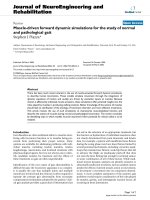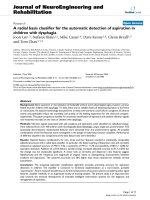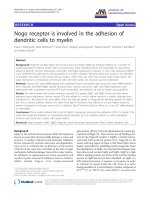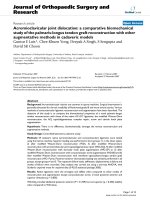báo cáo hóa học: " Muscle-driven forward dynamic simulations for the study of normal and pathological gait" potx
Bạn đang xem bản rút gọn của tài liệu. Xem và tải ngay bản đầy đủ của tài liệu tại đây (284.27 KB, 7 trang )
BioMed Central
Page 1 of 7
(page number not for citation purposes)
Journal of NeuroEngineering and
Rehabilitation
Open Access
Review
Muscle-driven forward dynamic simulations for the study of normal
and pathological gait
Stephen J Piazza*
Address: Departments of Kinesiology, Mechanical Engineering, and Orthopaedics and Rehabilitation, University Park, PA and Hershey, PA, USA
Email: Stephen J Piazza* -
* Corresponding author
Abstract
There has been much recent interest in the use of muscle-actuated forward dynamic simulations
to describe human locomotion. These models simulate movement through the integration of
dynamic equations of motion and usually are driven by excitation inputs to muscles. Because
motion is effected by individual muscle actuators, these simulations offer potential insights into the
roles played by muscles in producing walking motions. Better knowledge of the actions of muscles
should lead to clarification of the etiology of movement disorders and more effective treatments.
This article reviews the use of such simulations to characterize musculoskeletal function and
describe the actions of muscles during normal and pathological locomotion. The review concludes
by identifying ways in which models must be improved if their potential for clinical utility is to be
realized.
Introduction
Gait disorders are often attributed either to muscles inter-
fering with locomotor function or to muscles being pre-
vented from performing their proper actions. Many
options are available for addressing problems with indi-
vidual muscles, including tendon transfers, tendon
lengthenings, osteotomies, and localized treatment with
pharmacological agents, but it is not always easy to iden-
tify candidate muscles for treatment and the effects of
these treatments on gait are often unpredictable.
Identification of the root causes of gait abnormalities is
difficult because the locomotor apparatus is so complex.
It is usually the case that multiple joints and multiple
muscles are involved and the clinician is often required to
separate the primary gait abnormality from secondary
compensatory mechanisms adopted by the patient. Clini-
cal gait analysis provides a great deal of information that
can aid in the selection of an appropriate treatment, but
the function or dysfunction of individual muscles is often
not clearly determined from joint kinematic and kinetic
data. For example, a patient with insufficient knee flexion
during the swing phase may have knee flexion limited by
several potential mechanisms, including: overactive quad-
riceps that restrain knee flexion; weak hip flexors that fail
to advance the thigh; an inadequate push-off that does
not start the knee flexing fast enough in terminal stance;
or some combination of all of these factors. While tradi-
tional inverse dynamic analysis can identify excessive or
abnormally small joint moments, such an analysis cannot
predict the effects of altered muscle action on movement,
or decompose a movement into its component determi-
nants. A more complete assessment of the patient's gait
problems would require consideration of the roles played
by muscles, gravity, and intersegment reaction forces, all
occurring in three dimensions.
Published: 06 March 2006
Journal of NeuroEngineering and Rehabilitation2006, 3:5 doi:10.1186/1743-0003-3-5
Received: 04 October 2005
Accepted: 06 March 2006
This article is available from: />© 2006Piazza; licensee BioMed Central Ltd.
This is an Open Access article distributed under the terms of the Creative Commons Attribution License ( />),
which permits unrestricted use, distribution, and reproduction in any medium, provided the original work is properly cited.
Journal of NeuroEngineering and Rehabilitation 2006, 3:5 />Page 2 of 7
(page number not for citation purposes)
The purpose of the present paper is to review the applica-
tion of one form of computer simulation, forward dynamic
musculoskeletal simulation, to the study of normal and
pathological walking. Much excellent work has been pub-
lished that describes the development of techniques that
have made simulations of movement faster or more accu-
rate, but this review is focused on clinical applications
rather than modeling methods. The reader interested in a
more general treatment of technical advances in muscu-
loskeletal modeling and simulation is referred to
Yamaguchi's textbook [1] and to previous reviews by
Zajac et al. [2-4], Neptune [5], Hatze [6], and Pandy [7].
Forward dynamic musculoskeletal simulation
In a forward dynamic simulation, differential equations
of motion are numerically integrated forward in time sub-
ject to gravity, inertial and velocity-dependent effects, and
muscle forces. It is a 'forward' simulation in the sense that
forces produce motions and is distinct from inverse
dynamic analyses in which internal (muscular) moments
are computed from measured motions and external
forces. One advantage of solving for motion through
numerical integration of equations of motion rather than
applying conditions of equilibrium in a static or quasi-
static formulation is that there is no theoretical limitation
on the number of degrees of freedom or the number of
unknown forces that must be determined. If state equa-
tions can be written that describe the multibody dynamics
of the body segments and joints as well as the computa-
tion of forces applied to those segments, then those equa-
tions can be used to predict positions and velocities going
forward from some initial state.
A dizzying array of technical choices is made when for-
ward dynamic simulations like the ones described in this
review are created. A partial list includes the following: the
number of degrees of freedom in the model; the body seg-
ment inertial parameters; kinematic behavior of the
joints; the bony geometry and muscle attachment loca-
tions; the mathematical model of muscle force genera-
tion; the muscle force generating properties; modeling of
ligamentous restraints to joint motion; modeling of con-
tact between the feet and the ground; modeling of contact
within the joints; the method used to integrate the equa-
tions of motion. Also important is the scheme used to
arrive at the set of muscle excitation inputs that drive the
motion. These inputs may be derived directly from meas-
ured muscle activity, or indirectly using an optimization
algorithm that minimizes some objective function such as
the aggregate deviation from a given motion. Each of
these choices has the potential to affect the performance
of the simulation and thus may also affect the validity of
clinical applications of such models.
Model-based determination of internal forces
Knowledge of the forces carried by ligaments, tendons,
and joints under normal conditions are of clinical interest
but such measurements cannot be made readily without
substantially invasive procedures. Computer simulation
permits full monitoring of quantities such as joint contact
loads and soft tissue forces. In this way, a model of the
musculoskeletal system can be 'instrumented' in ways that
would be impossible with a living human subject. An
unlimited number of soft tissue tensions and joint contact
forces may be monitored during a simulation without the
slightest disturbance to the simulation output.
One example of a soft-tissue tension that is both of high
clinical relevance and difficult to monitor in vivo is the
force carried by the anterior cruciate ligament (ACL). In
two recent studies, Shelburne et al. [8,9] investigated ACL
loading and the mechanics of the ACL-deficient knee dur-
ing gait. Two models were employed for this purpose. A
three-dimensional dynamic simulation of the whole body
walking was performed with a constrained, single-degree-
of-freedom knee to determine joint kinematics, muscle
forces, and ground reaction forces; these outputs were
then used in an unconstrained static knee model to com-
pute both the loads carried by ligaments and the transla-
tions within the knee at every timestep during the gait
cycle. The authors found that the ACL carried loads
throughout the stance phase and that these loads peaked
early in stance. The medial collateral ligament was found
to be the structure that compensated most when the ACL
was removed, although the overall shear loading of the
knee was reduced by changes in the anterior tibial transla-
tion.
Knee loading has also been investigated by authors using
models that incorporated articular contact modeling into
dynamic simulations. Contact formulations have been
employed that assume the contacting bodies are rigid
[10,11], employ a deformable elastic foundation on a
rigid substrate [12-14], or incorporate finite-element
models of contact [12]. Halloran et al. [12] reported sim-
ilar results both for models of total knee replacement
motions incorporating finite-element modeling of con-
tact and for less computationally expensive elastic foun-
dation models. Fregly et al. [14] demonstrated that
dynamic simulations incorporating elastic foundation
models can predict in vivo wear patterns in total knee
replacement components and have the potential to
develop into useful tools for implant design.
Sasaki and Neptune [15-17] used a dynamic simulation to
investigate the factors that influence the walk-to-run tran-
sition. Previous investigations on this topic have not
revealed an apparent kinematic or kinetic factor that trig-
gers this gait transition in humans [18,19], though
Journal of NeuroEngineering and Rehabilitation 2006, 3:5 />Page 3 of 7
(page number not for citation purposes)
Prilusky and Gregor [20] noted differences in the electro-
myographic activity of flexor and extensor muscles above
and below the transition speed. The simulations of Sasaki
and Neptune illustrated that muscle fibers do more work
during running below the transition speed than during
walking at the same speed [16]. It was also found that
above the transition speed, more fiber work is done dur-
ing walking than during running, and that greater use was
made of energy storage in tendons when running above
the transition speed than below. These modeling results
suggest that efficient storage and expenditure of mechani-
cal energy on the part of muscle-tendon units plays a key
role in the walk-run transition. Further simulations [15]
suggested that the function of the ankle plantarflexors, in
particular, are affected by gait selection near the transition
speed. At walking speeds that approach the transition
speed, the force-length-velocity properties of the plantar-
flexors make them less able to generate force. When a run-
ning gait is adopted, plantarflexor forces increase due to
these muscles operating in a more favorable range.
Several authors have performed dynamic simulations to
investigate potentially dangerous activities that would be
unethical or impractical to study through experimenta-
tion on human subjects. Simulations of the landing phase
of a side-shuffle movement [21,22] and a sidestep cutting
movement [23] have been performed to identify factors
that may lead to injury. Wright et al. [22], for example,
used a muscle-actuated simulation to investigate the pas-
sive subtalar joint moment and subtalar joint rotations
that followed from landing subject to a number of irregu-
lar floor conditions. The authors used passive nonlinear
joint restraint moments at the talocrural and subtalar
joints to represent ligaments and bony constraints. They
found that increased plantar flexion at touchdown, rather
than increased subtalar supination, was associated with
subsequent sprains in a side-shuffle movement. McLean
et al. [23] performed a similar analysis in which a muscle-
actuated model was used to evaluate changes in knee joint
loads that resulted from altered muscle activations. Knee
loads exceeding a given threshold were deemed sufficient
to rupture the anterior cruciate ligament. Anterior drawer
forces were never found to be great enough to rupture the
ligament, suggesting that valgus loading is a more likely
mechanism.
Analyses of muscle function during normal
walking
A large-scale dynamic simulation of walking is only possi-
ble with an appropriate set of muscle excitation patterns
that keep the model moving forward and prevent it from
falling down. This set of simulation inputs is usually
determined through a dynamic optimization procedure.
This optimization may minimize the differences between
simulated and measured motions and ground reaction
forces, but other choices for the performance criterion can
provide useful information about walking mechanics.
Noting that the energetic cost of locomotion (energy con-
sumed per unit distance travelled) has a minimum near
the preferred walking speed in humans, Anderson and
Pandy [24] created a performance criterion that repre-
sented the metabolic energy consumed by all muscles per
unit distance travelled in a whole-body simulation of
walking. The set of muscle excitations that minimized this
energy expenditure, subject to the condition that the ter-
minal and initial conditions be equal, resulted in a highly
realistic simulation of normal gait. This work was an
important advance over earlier dynamic optimization
efforts employing models that included only a few mus-
cles [25,26] or that were restricted to the sagittal plane
[25,27].
Like walking humans, large-scale walking simulations are
prone to falling and are thus useful for studying stability.
Gerritsen et al. [28] used a dynamic simulation of walking
to investigate the means by which muscles aid in recovery
from perturbations to gait. The authors simulated walking
using four models that were identical except for the for-
mulation of the muscle model. The model most resistant
to perturbation was a muscle-actuated model whose mus-
cles incorporated both the force-length and force-velocity
properties. This model performed better than did models
with muscles lacking either of these properties or a model
actuated by moments rather than muscle forces.
Yamaguchi and Zajac [26] also investigated requirements
for stable walking using dynamic simulations in order to
identify the muscle groups needed for sustained level
walking. The authors reported that walking was possible
with seven muscle groups per leg and a minimum level of
ankle plantarflexor strength.
Walking simulations have also be used to challenge (or
confirm) traditional thinking on human locomotion. The
classical theory of the determinants of normal walking
proposed by Saunders et al. [29] states that there are seven
characteristics of gait that minimize energy consumption
by attenuating oscillations of the center of mass (COM).
The results of more recent experimental studies have sug-
gested that some of the determinants are less important
than others in producing movements of the COM [30], or
even that minimizing COM movements has the opposite
effect of increasing the metabolic energy cost [31].
Dynamic simulation permits examination of these issues
at a level not possible in experiments because it affords
the investigator access to many mechanical variables of
interest. Pandy and Berme [32] used a dynamic simula-
tion to investigate contributions to the ground reaction
force (and thus also the COM acceleration) by individual
determinants and found pelvic list to be less important to
the ground reaction force than other determinants such as
Journal of NeuroEngineering and Rehabilitation 2006, 3:5 />Page 4 of 7
(page number not for citation purposes)
stance phase knee flexion. Neptune et al. [33] used a
dynamic simulation to show that muscles do substantial
work in raising the COM in early stance, a finding that
perhaps highlights deficiencies in simpler models of walk-
ing as an inverted pendulum [34,35].
Many investigators who have created dynamic simula-
tions of walking have used those simulations to character-
ize the actions of individual muscles. One way in which
this is accomplished is by examining the accelerations
produced by muscle forces. During the simulation, accel-
erations are produced by forces acting in combination:
multiple muscle forces, gravity, and ground reaction
forces, for example. To determine the accelerations pro-
duced by a single muscle force acting in isolation, it is nec-
essary only to set all other forces equal to zero in the
equations of motion at a given instant in time and com-
pute the accelerations resulting from the remaining force
of interest. The accelerations determined using such an
induced acceleration analysis (IAA) may be rotational
accelerations at joints or the linear accelerations of points
such as the body's COM. Zajac et al. [3] importantly noted
that the induced acceleration computation does not
require a simulation; it is made instantaneously using the
equations of motion. The value of the simulation is that it
produces the history of model kinematics and forces nec-
essary to make induced acceleration computations at any
instant during the gait cycle. An alternate method for
assessment of muscle roles is to compute the amount each
muscle contributes to the power of individual body seg-
ments.
Neptune et al. [36] used IAA and segmental power analy-
sis to differentiate between the roles of gastrocnemius and
soleus during the stance phase of normal walking. Though
these muscles are often grouped together functionally as
plantarflexors of the ankle, important differences were
discovered between the function of the biarticular gastroc-
nemius and the uniarticular soleus. While both muscles
contribute to vertical support of the trunk, in mid-stance
gastrocnemius increases the stance leg energy and
restrains the forward motion of the trunk; soleus has the
opposite effects. In late stance, the initiation of swing was
found to be due to gastrocnemius alone. Anderson and
Pandy [37] also found that the plantarflexors contributed
to trunk support. By decomposing the ground reaction
force (which is directly related to the acceleration of the
COM) into its components due to individual muscles, it
was possible to determine that the second peak in the ver-
tical ground reaction force was caused by the plantarflex-
ors, while the first peak was caused by knee and hip
extensors. In a second study by Neptune et al. [38], similar
roles were identified for the vasti and gluteals in early
stance, and the plantarflexors were found to contribute
most to a net forward muscular acceleration of the trunk
in late stance. Riley et al. [39] reached a different conclu-
sion regarding the role of the plantarflexors in propulsion,
but their study examined the accelerations of the hip
rather than the trunk COM [40].
Dynamic simulation has also been used to investigate the
determinants of knee flexion during the swing phase of
gait. Piazza and Delp [41] used a dynamic simulation to
perform sensitivity analyses and IAA that indicated that
hip flexion moment and the knee flexion velocity at toe-
off contribute to knee flexion later in swing. Knee exten-
sion moment had the expected effect of reducing knee
flexion, but the role of the biarticular rectus femoris was
less clear. IAA revealed that rectus femoris provided a
slight restraint to knee flexion in early swing. Anderson et
al. [42] integrated the induced accelerations and initial
velocities during the early part of swing phase to arrive at
'induced positions', the contribution of individual com-
ponents to later joint rotation. The toe-off knee flexion
velocity was found to be the major determinant of subse-
quent knee flexion in swing, with some muscles aiding in
knee flexion and others having the opposite action. In a
second study by Goldberg et al. [43], the authors investi-
gated the factors influencing knee flexion velocity in late
stance by altering the forces carried by each muscle and
observing the resulting change in velocity. Vasti, rectus
femoris, and soleus were all identified as potentially lim-
iting of knee flexion velocity, while extra force applied by
iliopsoas and gastrocnemius were found to increase knee
flexion.
These studies provide helpful characterizations of normal
gait that have implications for the identification of prob-
lems in pathological gait. For example, if hip flexor force
is found to be an important determinant of the toe-off
knee flexion velocity and of knee flexion in swing phase,
then hip flexor weakness is implicated as a potential cause
of stiff knee gait, in which knee flexion during swing
phase is lacking [41,43]. An alternate approach would be
to proceed directly to simulations of pathological gait in
order to directly assess its causes.
Simulations of pathological gait
It is possible to recreate the gaits of patients with move-
ment disorders by forcing the simulation to track experi-
mentally measured kinematic and kinetic data [44-49].
The result is a reproduction of the pathological gait pat-
tern that can be examined using the same IAA and power
analyses employed to study normal walking.
Although the most common surgical treatment for stiff
knee gait is rectus femoris transfer to reduce knee exten-
sion moment, the results of dynamic simulations have
suggested that this gait disorder is potentially caused by
several factors [44-46]. Riley and Kerrigan [44] created
Journal of NeuroEngineering and Rehabilitation 2006, 3:5 />Page 5 of 7
(page number not for citation purposes)
subject-specific simulations of patients with stiff knee gait
and found abnormal induced rotational accelerations at
the knee that could result from abnormalities at either the
hip or ankle, but results varied widely across patients.
Goldberg et al. [46] also created models of individual
patients' stiff knee gaits, finding that only one of 18 limbs
displayed an abnormally large knee extension moment,
while 15 of 18 exhibited reduced knee flexion velocity at
toe-off.
Simulations of individual patients' gaits were also created
by Higginson et al. [47] and Siegel et al. [48] to investigate
coordination and control in subjects with gait disorders.
Higginson et al. compared simulations of subjects with
post-stroke hemiparesis to simulations of speed-matched
controls, and found that support of the body weight was
achieved by using an altered strategy that compensated for
abnormal contributions from affected muscles. A similar
study by Siegel et al. involved simulations of the individ-
ual gaits of patients with quadriceps weakness. IAA
revealed that subjects used different strategies to produce
knee extension when it could not be obtained from knee
extensors directly.
Recreations of pathological gait patterns were also used by
Arnold et al. [49], who analyzed the muscular contribu-
tions to knee flexion and extension accelerations in simu-
lations of normal gait in order to study potential causes of
crouch gait. The results suggested that the increased knee
flexion that characterizes crouch gait may be caused by
weakness in hip extensors, knee extensors, or soleus.
Hamstrings spasticity is frequently cited as a cause of
crouch gait and the hamstrings are often lengthened to
treat this condition, but the hamstrings in the simulation
were found to produce a small knee extension accelera-
tion during mid-stance.
Future progress in creating clinical applicable
simulations
Although dynamic musculoskeletal simulation of human
locomotion is usually driven by clinical questions, much
more work has been done in creating simulations of nor-
mal gait than pathological gait. There are several good rea-
sons for this: the walking patterns of healthy people are
well-defined and stereotypical, making it easy to know
when the simulated gait approximates a normal pattern;
there are much more data upon which to base models of
joints and muscles for young, healthy subjects; it is diffi-
cult to create the subject-specific models necessary to
models the gaits of individual patients; there are perform-
ance criteria that seem to produce the correct excitation
patterns for normal gait, but it is unclear what, if anything,
is optimized in pathological walking. At present, dynamic
simulations are used only as descriptive tools that provide
insight into the mechanics of locomotion that is not pos-
sible with motion analysis and inverse dynamics alone.
Dynamic simulations can provide information about the
roles played by muscles in replications of normal and dis-
ordered gait, and can be used to estimate quantities not
easily measured in experiments. In the future, however, it
may be possible to use simulation as a preoperative plan-
ning tool used to predict the effects of surgery in a specific
patient.
There is much promising work being done that will per-
mit more realistic simulations of normal gait and that will
hasten the development of accurate models of the gait of
patients with movement disorders. More research is
needed in the following areas if these goals are to be
attained:
• Better descriptions of the force-generating properties of
muscles and ligaments
Musculotendon actuators in the musculoskeletal models
used to carry out dynamic simulations are usually repre-
sented by Hill-type muscle models. The models are used
to compute forces based on force-length and force-veloc-
ity relations that are scaled by a few muscle-specific
parameters, such as optimal fiber length. Values of these
parameters are drawn from a handful of studies on cadav-
ers, each of which reports on only a few specimens. More
such studies would be helpful in establishing normative
values, but another potentially productive approach is to
develop optimization schemes that will permit subject-
specific force-generating properties to be determined from
measured forces and motions [50-53]. Ligaments in mus-
culoskeletal models are usually represented by torsional
springs that resist excessive joint rotations, but more
explicit representations will be required to predict the
effects of orthopaedic surgeries on ligament tensions.
• More complex models of muscle geometry and
architecture
For the most part, muscles have been modelled as inde-
pendent actuators that follow straight, segmented, or
curved paths from origin to insertion. They may wrap
around objects intended to represent bones, retinacula, or
other muscles, but more work is necessary to account for
the complex architecture of some muscles [54-57] and for
mechanical and neurological coupling between muscles
[58,59]. Fascial connections and synergistic activation of
muscle groups are potentially important constraints not
included in current models.
• More complex models of joints
In nearly all of the simulations described in this review,
the knee is represented as a single-degree-of-freedom joint
whose translations and rotations are either held fixed or
prescribed as functions of the knee flexion angle, a
description at odds with the behavior of actual knees that
Journal of NeuroEngineering and Rehabilitation 2006, 3:5 />Page 6 of 7
(page number not for citation purposes)
exhibit a substantial degree of laxity even when healthy.
The ankles are represented by a pair of fixed, skewed
hinges, but we know that one of these joints, the talocru-
ral, changes its orientation as the joint rotates, and the
other, the subtalar, exhibits a high degree of intersubject
variability in its orientation [60]. We know that mobility
in the joints of the foot is important to normal locomo-
tion, but the foot is usually modeled as a rigid block.
Accurate descriptions of joint kinematics are especially
important when tendons pass close to joint axes, as is the
case at the ankle, because the moments produced by such
muscles will be especially sensitive to joint position.
Methods for identifying subject-specific joint kinematics
[61] will help in this regard, as will studies that assess the
effects of using generic joint models.
• Means for validation
The results of dynamic simulations are likely to be sensi-
tive to the degree of complexity in the formulation of the
model [62], but most of the simulations described in this
review are based on very similar musculoskeletal models.
When different sets of model parameters are used to create
simulations with similar results, this will provide some
degree of validation in that the results will prove to be
robust with respect to variation in those parameters. The
extent of the validation of dynamic simulation results is
usually limited to comparisons of the kinematic, kinetic,
and electromyographic outputs to their experimentally-
measured counterparts. Unfortunately, there is no means
currently available for making a direct measurement of
the acceleration produced by the action of a single muscle
in human subjects, and direct validation of muscle
induced acceleration analyses remains a challenge.
Conclusion
The use of muscle-driven forward dynamic simulations to
study human locomotion is becoming increasingly com-
mon; fifteen such studies cited in this article were pub-
lished in the last eighteen months. A great deal of
excellent work has been done to facilitate the creation of
realistic simulations of walking and to begin describing
the mechanics of walking in terms only possible through
the use of simulation. Motion analysis describes the
motions and external forces present during gait, and
inverse dynamics gives further information about joint
kinetics. Both of these tools are widely used in clinical gait
analysis. The present challenge is to devise measures of
gait performance based on dynamic simulation output
and to make these measures applicable to the treatment of
patients with movement disorders.
Acknowledgements
Support for this work was provided by the National Science Foundation
(BES-0134217).
References
1. Yamaguchi GT: Dynamic Modeling of Musculoskeletal Motion.
New York, Springer; 2001.
2. Zajac FE: Muscle and tendon: properties, models, scaling, and
application to biomechanics and motor control. Crit Rev
Biomed Eng 1989, 17:359-411.
3. Zajac FE, Neptune RR, Kautz SA: Biomechanics and muscle coor-
dination of human walking. Part I: introduction to concepts,
power transfer, dynamics and simulations. Gait Posture 2002,
16:215-232.
4. Zajac FE, Neptune RR, Kautz SA: Biomechanics and muscle coor-
dination of human walking: part II: lessons from dynamical
simulations and clinical implications. Gait Posture 2003, 17:1-17.
5. Neptune RR: Computer modeling and simulation of human
movement. Applications in sport and rehabilitation. Phys Med
Rehabil Clin N Am 2000, 11:417-34, viii.
6. Hatze H: Fundamental issues, recent advances, and future
directions in myodynamics. J Electromyogr Kinesiol 2002,
12:447-454.
7. Pandy MG: Computer modeling and simulation of human
movement. Annu Rev Biomed Eng 2001, 3:245-273.
8. Shelburne KB, Pandy MG, Anderson FC, Torry MR: Pattern of
anterior cruciate ligament force in normal walking. J Biomech
2004, 37:797-805.
9. Shelburne KB, Pandy MG, Torry MR: Comparison of shear forces
and ligament loading in the healthy and ACL-deficient knee
during gait. J Biomech 2004, 37:313-319.
10. Piazza SJ, Delp SL: Three-dimensional dynamic simulation of
total knee replacement motion during a step-up task. J Bio-
mech Eng 2001, 123:599-606.
11. Caruntu DI, Hefzy MS: 3-D anatomically based dynamic mode-
ling of the human knee to include tibio-femoral and patello-
femoral joints. J Biomech Eng 2004, 126:44-53.
12. Halloran JP, Petrella AJ, Rullkoetter PJ: Explicit finite element
modeling of total knee replacement mechanics. J Biomech
2005, 38:323-331.
13. Bei Y, Fregly BJ: Multibody dynamic simulation of knee contact
mechanics. Med Eng Phys 2004, 26:777-789.
14. Fregly BJ, Sawyer WG, Harman MK, Banks SA: Computational
wear prediction of a total knee replacement from in vivo kin-
ematics. J Biomech 2005, 38:305-314.
15. Neptune RR, Sasaki K: Ankle plantar flexor force production is
an important determinant of the preferred walk-to-run tran-
sition speed. J Exp Biol 2005, 208:799-808.
16. Sasaki K, Neptune RR: Muscle mechanical work and elastic
energy utilization during walking and running near the pre-
ferred gait transition speed. Gait Posture 2005 in press.
17. Sasaki K, Neptune RR: Differences in muscle function during
walking and running at the same speed. J Biomech 2005 in press.
18. Hreljac A: Preferred and energetically optimal gait transition
speeds in human locomotion. Med Sci Sports Exerc 1993,
25:1158-1162.
19. Hreljac A: Determinants of the gait transition speed during
human locomotion: kinematic factors. J Biomech 1995,
28:669-677.
20. Prilutsky BI, Gregor RJ: Swing- and support-related muscle
actions differentially trigger human walk-run and run-walk
transitions. J Exp Biol 2001, 204:2277-2287.
21. Wright IC, Neptune RR, van den Bogert AJ, Nigg BM: The effects of
ankle compliance and flexibility on ankle sprains. Med Sci
Sports Exerc 2000, 32:260-265.
22. Wright IC, Neptune RR, van den Bogert AJ, Nigg BM: The influence
of foot positioning on ankle sprains. J Biomech 2000, 33:513-519.
23. McLean SG, Huang X, Su A, Van Den Bogert AJ: Sagittal plane bio-
mechanics cannot injure the ACL during sidestep cutting.
Clin Biomech 2004, 19:828-838.
24. Anderson FC, Pandy MG: Dynamic optimization of human
walking. J Biomech Eng 2001, 123:381-390.
25. Davy DT, Audu ML: A dynamic optimization technique for pre-
dicting muscle forces in the swing phase of gait. J Biomechanics
1987, 20:187-201.
26. Yamaguchi GT, Zajac FE: Restoring unassisted natural gait to
paraplegics via functional neuromuscular stimulation: a
computer simulation study. IEEE Trans Biomed Eng 1990,
37:886-902.
Publish with BioMed Central and every
scientist can read your work free of charge
"BioMed Central will be the most significant development for
disseminating the results of biomedical research in our lifetime."
Sir Paul Nurse, Cancer Research UK
Your research papers will be:
available free of charge to the entire biomedical community
peer reviewed and published immediately upon acceptance
cited in PubMed and archived on PubMed Central
yours — you keep the copyright
Submit your manuscript here:
/>BioMedcentral
Journal of NeuroEngineering and Rehabilitation 2006, 3:5 />Page 7 of 7
(page number not for citation purposes)
27. Chow CK, Jacobson DH: Studies of human locomotion via opti-
mal programming. Math Biosci 1971, 10:239-306.
28. Gerritsen KG, van den Bogert AJ, Hulliger M, Zernicke RF: Intrinsic
muscle properties facilitate locomotor control - a computer
simulation study. Motor Control 1998, 2:206-220.
29. Saunders JBDCM, Inman VT, Eberhart HD: The major determi-
nants in normal and pathological gait. JBJS 1953, 35-A:543-558.
30. Gard SA, Childress DS: The influence of stance-phase knee flex-
ion on the vertical displacement of the trunk during normal
walking. Arch Phys Med Rehabil 1999, 80:26-32.
31. Ortega JD, Farley CT: Minimizing center of mass vertical move-
ment increases metabolic cost in walking. J Appl Physiol 2005.
32. Pandy MG, Berme N: Quantitative assessment of gait determi-
nants during single stance via a three-dimensional model
Part 1. Normal gait. J Biomech 1989, 22:717-724.
33. Neptune RR, Zajac FE, Kautz SA: Muscle mechanical work
requirements during normal walking: the energetic cost of
raising the body's center-of-mass is significant. J Biomech 2004,
37:817-825.
34. Mochon S, McMahon TA: Ballistic walking. J Biomechanics 1980,
13:49-57.
35. Alexander RM: Energy-saving mechanisms in walking and run-
ning. J Exp Biol 1991, 160:55-69.
36. Neptune RR, Kautz SA, Zajac FE: Contributions of the individual
ankle plantar flexors to support, forward progression and
swing initiation during walking. J Biomech 2001, 34:1387-1398.
37. Anderson FC, Pandy MG: Individual muscle contributions to
support in normal walking. Gait Posture 2003, 17:159-169.
38. Neptune RR, Zajac FE, Kautz SA: Muscle force redistributes seg-
mental power for body progression during walking. Gait Pos-
ture 2004, 19:194-205.
39. Riley PO, Della Croce U, Kerrigan DC: Propulsive adaptation to
changing gait speed. J Biomech 2001, 34:197-202.
40. Neptune RR, Kautz SA, Zajac FE: Comments on "Propulsive
adaptation to changing gait speed". J Biomech 2001,
34:1667-1670.
41. Piazza SJ, Delp SL: The influence of muscles on knee flexion
during the swing phase of gait. J Biomech 1996, 29:723-733.
42. Anderson FC, Goldberg SR, Pandy MG, Delp SL: Contributions of
muscle forces and toe-off kinematics to peak knee flexion
during the swing phase of normal gait: an induced position
analysis. J Biomech 2004, 37:731-737.
43. Goldberg SR, Anderson FC, Pandy MG, Delp SL: Muscles that influ-
ence knee flexion velocity in double support: implications for
stiff-knee gait. J Biomech 2004, 37:1189-1196.
44. Riley PO, Kerrigan DC: Kinetics of stiff-legged gait: induced
acceleration analysis. IEEE Trans Rehabil Eng 1999, 7:420-426.
45. Riley PO, Kerrigan DC: Torque action of two-joint muscles in
the swing period of stiff-legged gait: a forward dynamic
model analysis. J Biomech 1998, 31:835-840.
46. Goldberg SR, Ounpuu S, Delp SL: The importance of swing-
phase initial conditions in stiff-knee gait. J Biomech 2003,
36:1111-1116.
47. Higginson JS, Zajac FE, Neptune RR, Kautz SA, Delp SL: Muscle con-
tributions to support during gait in an individual with post-
stroke hemiparesis. J Biomech 2005 in press.
48. Siegel KL, Kepple TM, Stanhope SJ: Using induced accelerations
to understand knee stability during gait of individuals with
muscle weakness. Gait Posture 2005 in press.
49. Arnold AS, Anderson FC, Pandy MG, Delp SL: Muscular contribu-
tions to hip and knee extension during the single limb stance
phase of normal gait: a framework for investigating the
causes of crouch gait. J Biomech 2005, 38:2181-2189.
50. Thelen DG: Adjustment of muscle mechanics model parame-
ters to simulate dynamic contractions in older adults. J Bio-
mech Eng 2003, 125:70-77.
51. Lloyd DG, Besier TF: An EMG-driven musculoskeletal model to
estimate muscle forces and knee joint moments in vivo. J Bio-
mech 2003, 36:765-776.
52. Manal K, Buchanan TS: A one-parameter neural activation to
muscle activation model: estimating isometric joint
moments from electromyograms. J Biomech 2003,
36:1197-1202.
53. Garner BA, Pandy MG: Estimation of musculotendon proper-
ties in the human upper limb. Ann Biomed Eng 2003, 31:207-220.
54. Asakawa DS, Blemker SS, Rab GT, Bagley A, Delp SL: Three-dimen-
sional muscle-tendon geometry after rectus femoris tendon
transfer. J Bone Joint Surg Am 2004, 86-A:348-354.
55. Blemker SS, Pinsky PM, Delp SL: A 3D model of muscle reveals
the causes of nonuniform strains in the biceps brachii. J Bio-
mech 2005, 38:657-665.
56. Blemker SS, Delp SL: Rectus femoris and vastus intermedius
fiber excursions predicted by three-dimensional muscle
models. J Biomech 2005.
57. Blemker SS, Delp SL: Three-dimensional representation of
complex muscle architectures and geometries. Ann Biomed
Eng 2005, 33:661-673.
58. Thelen DD, Riewald SA, Asakawa DS, Sanger TD, Delp SL: Abnor-
mal coupling of knee and hip moments during maximal exer-
tions in persons with cerebral palsy. Muscle Nerve 2003,
27:486-493.
59. Riewald SA, Delp SL: The action of the rectus femoris muscle
following distal tendon transfer: does it generate knee flex-
ion moment? Dev Med Child Neurol 1997, 39:99-105.
60. Lundberg A: Kinematics of the ankle and foot. In vivo roentgen
stereophotogrammetry. Acta Orthop Scand Suppl 1989, 233:1-24.
61. Reinbolt JA, Schutte JF, Fregly BJ, Koh BI, Haftka RT, George AD,
Mitchell KH: Determination of patient-specific multi-joint kin-
ematic models through two-level optimization. J Biomech
2005, 38:621-626.
62. Chen G: Induced acceleration contributions to locomotion
dynamics are not physically well defined. Gait Posture 2005 in
press.
